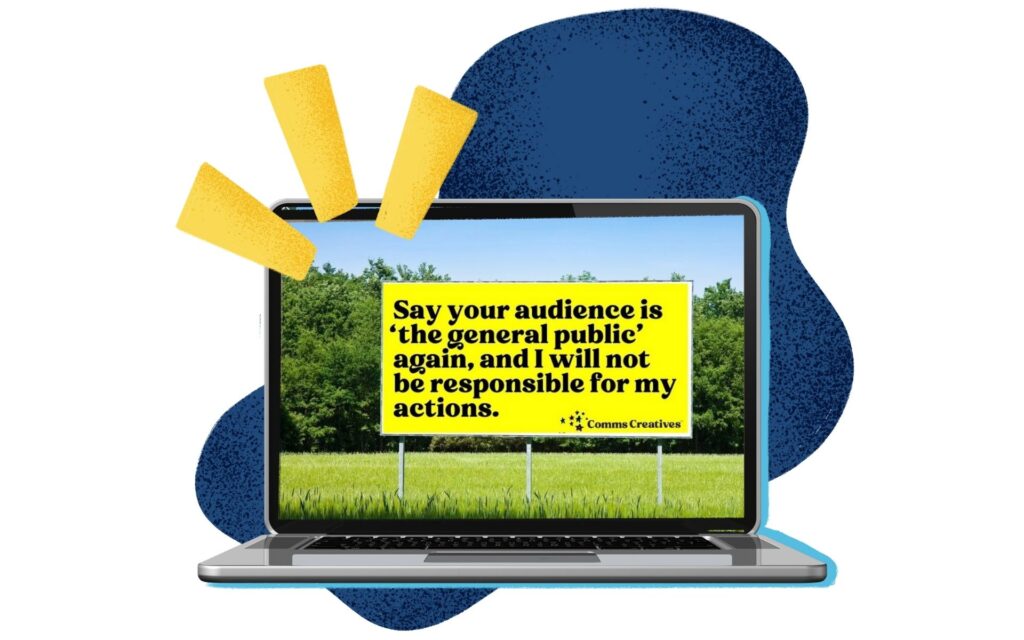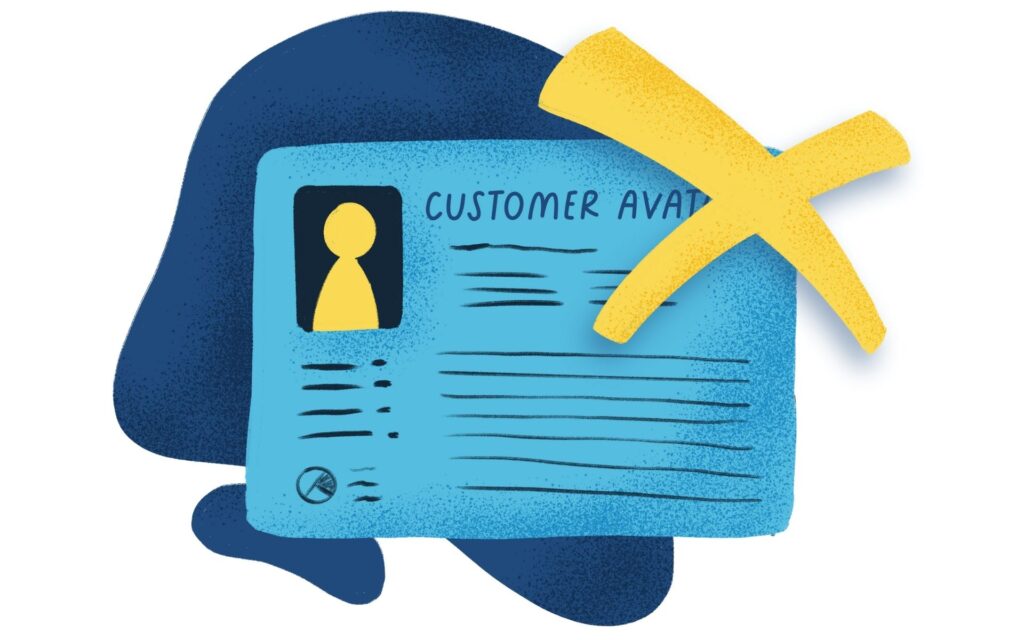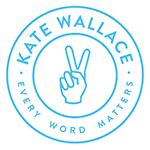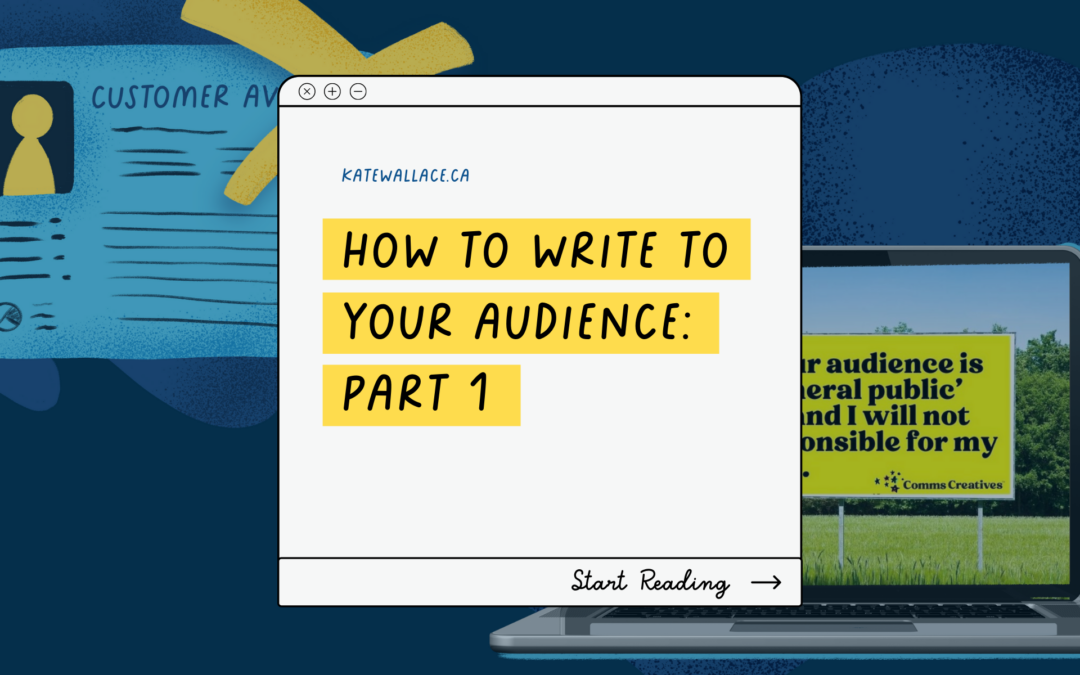I came across a great tweet by Comms Creative recently, a picture of a roadside billboard with a yellow background and the message in black type: “Say your audience is the general public again, and I will not be responsible for my actions.”

I laughed in recognition.
It’s possibly the most painful thing you can say to a marketer. If you’re everything to all people, you’re nothing to no one.
Harsh, yet true.
Specific is strategic. It makes your brand and offerings clear. It sets a tone and expectation for interactions. It shares the right information. It triggers emotions that lead to actions. Specificity is a clarion call to your audience.
And yet, in many organizations, content follows the industry herd resulting in look-alike vanilla posts. Or it’s based on gut feel and hope. And hope is not a (content) strategy.
Getting to Know “You”
One of the most obvious ways to understand your audience is to talk to them.
And yet, most companies don’t.
One of my clients, a consultant and coach with more than 30 years of experience in corporate America, told me recently that most of his clients don’t talk to their customers, to the detriment of their businesses, which is based on hunches rather than reality.
I was shocked. These are mid-sized companies with tens of millions of dollars in revenues. Surely they know what their clients think and value about them?
Reader, many do not.
These larger organizations haven’t done any outreach for the same reasons as small businesses: they’re busy with day-to-day operations; it’s time-consuming; it’s awkward asking clients what they think of you.
And it’s potentially cringe-y: maybe they’ll say something you don’t want to hear. But when it comes to audience insights, if you don’t ask, you don’t get. (Ooh, I’m salty today!).
But remember: it’s about them, not you.
Avatars: Just Say No!
If you’re an entrepreneur or marketer, you’ve probably been in a workshop where you had to create and name your “ideal customer avatar.” They read like this:
“‘Organic Olivia’ drives a vintage Saab and loves farmers’ markets. She spends weekends pruning his wisteria and reading the Great Books. She works in insurance and only wears beige. She wouldn’t be caught dead at Costco and thinks Medjools are the superior date. She’s a Virgo who doesn’t believe Mercury has anything to do with bad luck.”

Not only do you rather dislike the imaginary Olivia you created, but you wonder: WTF does this profile have to do with my business? How does it help me understand my customers, their motivations and desires at this moment? How does it help me better speak to and serve them?
Friend, there is another way. It’s called “Jobs To Be Done.” It’s a very grounded, humanist and practical approach that’s much more insightful about the customers you want to build stronger relationships with and communicate your value more clearly.
I learned about JTBD from Karyn Kelbaugh, a whiz-band customer researcher in Texas who I hired in 2020 to help me research potential clients’ feelings about writing for their business.
“We are living in our assumption bubbles and trying to ‘crack the code’ of how to get more people to want, buy and gush over our marvellous things,” Karyn writes on her website. “We just want them to tell us how to sell to them. We just want them to tell us what they want us to say.
“That is not their job. That is our job to discover and discern. It takes work, and it takes listening.”
Who to Ask?
Karyn uses JTBD (read her introductory blog on it) to learn about customer journeys, the progress they’re trying to make, and how your business fits into their story. When we worked together, she designed a series of questions to:
- Learn what clients/potential clients prefer for offering delivery
- Learn what value clients place on achieving their desired outcomes
- Gather language about how clients describe their situation, decision making, struggles and goals
- Identify themes and opportunities to guide service design
You don’t need to hire a pro like Karyn (although I can’t recommend her enough!) to start to gather some audience intel. You don’t need to survey your entire roster or list. Karyn interviewed a half-dozen people for our project. A fulsome interview with a carefully selected candidate is much more valuable than hundreds of shallow responses. Here are a few groups you can start with; choose 1 or 2 people from each category:
- Talk to your biggest, best clients (as Karyn says, the ones you “wish you could clone”)
- Talk to clients or audience members who seem keen but never bite
- Talk to those who seem to have lost interest–what wasn’t working for them?
What to Ask?
Over on the Copyhackers blog, Alan Clement writes about using the JTBD approach for copywriting, but it all applies to content, too. He suggests going after the specific details of a particular moment of struggle. I love his visual, specific way of framing it.
Alan says the most important things to pay attention to are:
- What specific words (adjectives & adverbs) your customers use. “Let them find the words, and press them to explain more.” he writes. “So when a customer describes something as “big” don’t say: “Oh yeah it IS really big”. Instead say ‘Big? What makes it big? Big compared to what? What else did you try that was big?’”
- Frequency. The more often a customer uses a word or phrase, the deeper its associations. This is especially valuable when multiple customers use the same ones. “If different customers keep saying that they like to use an air freshener because it reminds them of ”home.” Well. You’ve got some great copy ideas to start with.”
For a few ideas of questions you can ask your clients right now, check out Karyn’s podcast and post on this very topic.

And self-described customer research geek Katelyn Bourgoin, who also uses the JTBD approach, has a great Twitter thread on the four types of questions you need to ask when you’re doing customer discovery research for sales:
1. What triggers people to begin the buying journey?
2. What job are they trying to get done?
3. What are their pains with other solutions?
4. What are their selfish desires?
“People don’t buy because of who they are,” Katelyn writes. “They buy because they have specific ‘jobs’ they want to get done and they ‘hire’ products to help them. When you understand the job, you can position your product as the best solution.”
Non-Interview Audience Insights.
Along with talking to your customers, there are other simple ways to get insights:
- Read your comments. What do people ask about? What confuses them?
- Audit your content. What’s sticking? What’s not landing? What subjects or stories does it feature?
- Keep a list of questions you get during your onboarding sequence.
If you’ve been using avatars to create content for your customers and wondering why nothing’s sticking, don’t be discouraged. Start talking to your customers to figure out what really moves them.
I challenge you to do one customer interview this week. Let me know how it goes! And stay tuned for Part 2, where I’ll dig into advice for how to turn your audience insights into bullseye content.


